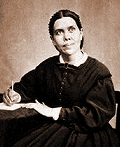|
The offerings presented to the Lord were to
be without blemish.3 These offerings
represented Christ, and from this it is evident that Jesus Himself
was free from physical deformity. He was the "lamb without blemish
and without spot." 1 Peter 1:19. His physical structure was not
marred by any defect; His body was strong and healthy. And
throughout His lifetime He lived in conformity to nature's laws.
Physically as well as spiritually, He was an example of what God designed all
humanity to be through obedience to His laws. |
The first of these was Circumcision,
representing voluntary subjection to the conditions of the Law, and
acceptance of the obligations, but also of the privileges, of the
Covenant between God and Abraham and his seed. Any attempt to show
the deep significance of such a rite in the case of Jesus, could
only weaken the impression which the fact itself conveys. The
ceremony took place, as in all ordinary circumstances, on the eight
day, when the Child received the Angel-given name Jeshua (Jesus).
Two other legal ordinances still remained to be observed. The
firstborn son of every household was, according to the Law, to be
'redeemed' of the priest at the price of five shekels of the
Sanctuary. [e Numb. xviii. 16] Rabbinic casuistry here added many
needless, and even repulsive, details. The following, however, are
of practical interest. The earliest period of presentation was
thirty-one days after birth so as to make the legal month quite
complete. The child must have been the firstborn of his mother
(according to some writers, of his father also); [1 So Lundius,
Jud. Alterth. p.621, and Buxtorf, Lex. Talmud. p. 1699.
But I am bound to say, that this seems contrary
to the sayings of the Rabbis.] neither father nor mother [2 This
disposes of the idea, that the Virgin-Mother was of direct Aaronic
or Levitic descent.] must be of Levitic descent; and the
child must be free from all such bodily blemishes3
as would have disqualified him for the
priesthood, or, as it was expressed: 'the
firstborn for the priesthood.' It was a thing much
dreaded, that the child should die before his redemption; but if
his father died in the interval, the child had to redeem himself
when of age. As the Rabbinic law expressly states, that the shekels
were to be of 'Tyrian weight,' [a Bechor viii. 7] the value of the
'redemption money' would amount to about ten or twelve shillings.
The redemption could be made from any priest, and attendance in the
Temple was not requisite. It was otherwise with the 'purification'
of the mother. [b Lev. xii.] The Rabbinic law fixed this at
forty-one days after the birth of a son, and eighty-one after that
of a daughter, [3 Archdeacon Farrar is mistaken in supposing, that
the 'thirty-three days' were counted 'after the circumcision.' The
idea must have arisen from a misunderstanding of the English
version of Lev. xii. 4. There was no connection between the time of
the circumcision of the child, and that of the purification of his
mother. In certain circumstances circumcision might have to be
delayed for days, in case of sickness, till recovery. It is equally
a mistake to suppose, that a Jewish mother could not leave the
house till after the forty days of her purification.] so as to make
the Biblical terms quite complete. [c Comp. Sifra, ed. Weiss, p. 59
a and b; Maimonides, Yad haChaz. Hal.Mechusre Capp., ed. Amst.,
vol. iii. p. 255 a and b.] But it might take place any time later,
notably, when attendance on any of the great feasts brought a
family to Jerusalem. Thus, we read of cases when a mother would
offer several sacrifices of purification at the same time. [4 Comp.
Kerith. i. 7.] But, indeed, the woman was not required to be
personally present at all, when her offering was presented, or,
rather (as we shall see), provided for, say, by the representatives
of the laity, who daily took part in the services for the various
districts from which they came. This also is specially provided for
in the Talmud. [5 Jer. Sheq. 50 b.] But mothers who were within
convenient distance of the Temple, and especially the more earnest
among them, would naturally attend personally in the Temple; [6
There is no ground whatever for the objection which Rabbi Low
(Lebensalter, p. 112) raises against the account of St. Luke.
Jewish documents only prove, that a mother need not personally
attend in the Temple; not that they did not do so, when attendance
was possible. The contrary impression is conveyed to us by Jewish
notices.] and in such cases, when practicable, the redemption of
the firstborn, and the purification of his mother, would be
combined. Such was undoubtedly the case with the Virgin-Mother and
her Son. |
But with the precious blood of Christ, as of a lamb without
blemish and without spot. (1 Pet. 1:19)
|


